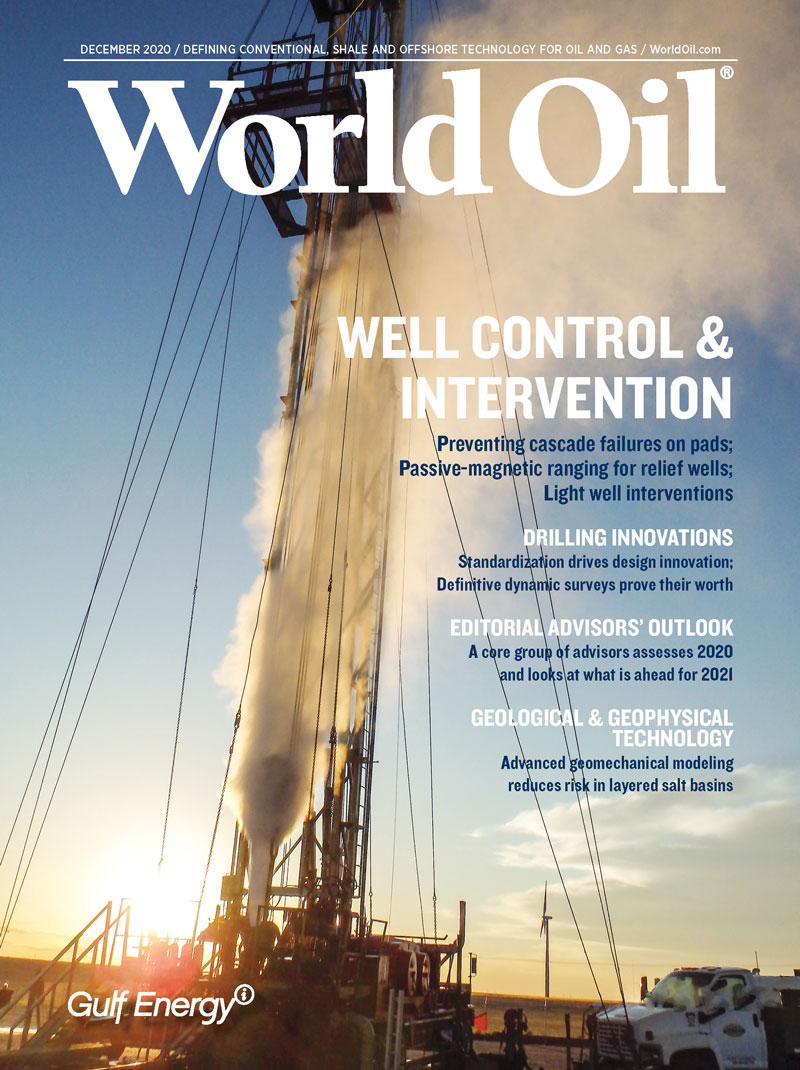Issue: December 2020
Special Focus
A new triangulation method, using MWD survey data, provides operators a viable ranging and homing option for well control contingency planning.
Vessel-based intervention set to increase as the next new normal sets in
When a pad well blows out, other nearby wells are in danger of blowout, posing a unique risk. Cascade failures require synergistic use of technologies and specialized expertise to properly respond to, and secure, multiple well blowouts.
Features
Unique geomechanical modeling technique mitigates geological and drilling-related risk in basins with layered evaporite sequences, which are not amenable to traditional structural analysis methods.
Large-scale data accumulation is becoming more common in shale development. However, the industry struggles with a data dilemma. On the one hand, operators know that they have to gather data to learn and improve. On the other hand, the learning and analysis require so much manpower that often the collected data are left unexplored.
A survey-while-drilling service performs definitive dynamic analysis as the BHA rotates, providing significant rig-time savings compared to conventional static MWD surveys. The ability to see continuous real-time borehole conditions optimizes drilling, reduces risks and eliminates survey-related NPT.
In a world of lower oil prices, product developers are recognizing that quality and reliability must be backed up by efficient supply chains and serviceability.
U.S. shale drillers lead the world—but even so, investing to improve drilling efficiency, well design, and back-office functions can deliver returns that far outweigh the costs.
While the various and constantly evolving Biden/Harris promises to ban hydraulic fracturing—at one level or another—dominated the narrative during the general election campaign, the approach they will choose to take on a range of oil and gas issues, now that they are in a position of power, will come into sharp relief.
In a pandemic-bedeviled year in which the entire business universe has been turned on end, it’s altogether fitting that long-troubled gas producers find themselves in what a leading Haynesville shale player describes as the “most bullish” market in more than a decade.
It is an understatement, to say that 2020 is the year that people want to forget—most people were “done’ with this year by about August. Nevertheless, it’s hard to ignore a year that was filled with so much impact, and which was deadly (Covid-19), tumultuous (oil market and prices) and unpredictable (politics, elections and regulation), often all at the same time. There were unprecedented social and business lockdowns in response to Covid-19 that killed demand. There were record-low oil prices and record-low rig counts that slashed activity. And there were record-high vote totals in the U.S., amid an election that just finally resolved itself on Dec. 14.
Against this background, a core group of our editorial advisors has worked to assess the global E&P industry during the last 12 months, and attempted to foresee what may take place in the coming year. Some of the subjects tackled by our advisors include a look at how to boost the global LNG market; continued uncertainty for the UK Continental Shelf; the carbon intensity of reserves, as the next step to net-zero; the role that Norwegian firms are playing in developing technology that will help the industry to prosper; a look at some talented leaders that are impacting the industry in its time of need; the true impact of digital oilfield technology; and a look at an Arctic oil field of the future, which is developing now. We encourage you to read forward for all the details.
Columns
Norway facing challenges
The challenges of high-performance bolts
Digital energy management: One certainty in a world of uncertainty
Hydrogen, a viable alternative
Déjà vu with a twist
Resources



